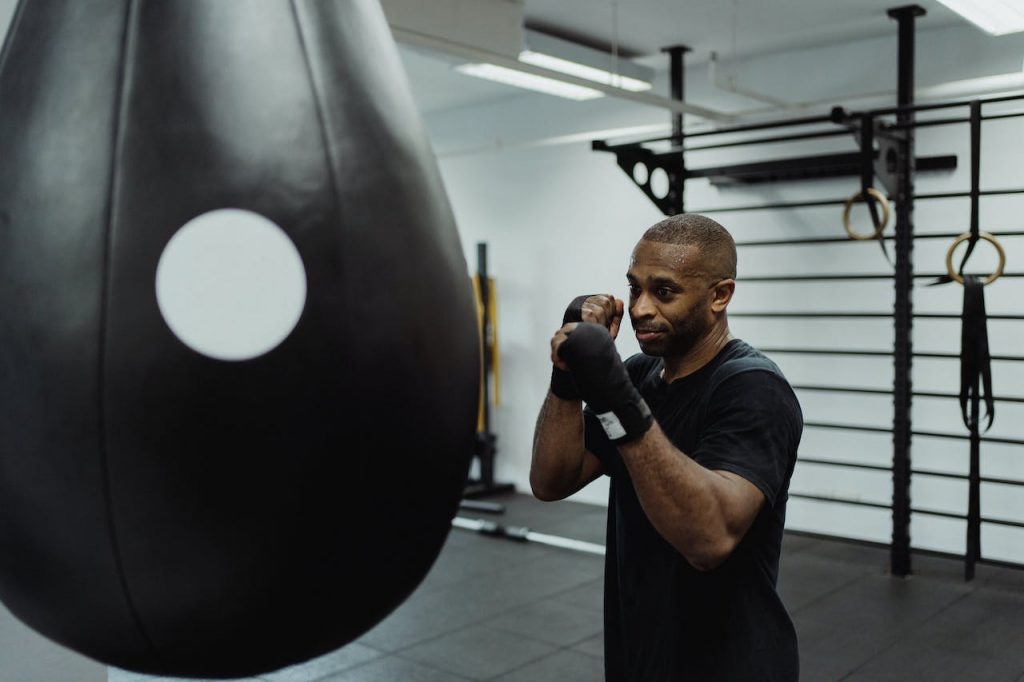
Enhancing Training and Safety with Boxing Straps
Ever wondered how to take your boxing training up a notch while ensuring safety? Boxing straps might just be the game-changer you need. These simple yet effective gym equipment can significantly enhance your performance and protect against injuries. From providing wrist support to improving punching technique, boxing straps offer a range of benefits that every boxer should consider.
Ready to elevate your training experience and safeguard yourself in the ring? Let’s delve into the world of boxing straps and uncover their remarkable impact on your workouts.
The Necessity of Hand Wraps for Training Safety
Essential Support
Boxing straps, also known as hand wraps, are essential for providing support and protection during boxing and kickboxing training. They help stabilize the bones, tendons, and muscles, reducing the likelihood of injury. Without this crucial support, there’s a significant risk of injuries such as fractures, sprains, and strains.
Hand wraps play a vital role in ensuring that your wrists are adequately protected while you engage in intense training sessions. By securing the delicate structures, they minimize the impact force on your bones and soft tissues. This means that with each punch or strike you throw during training or sparring sessions, your hands are shielded from excessive strain.
Reduced Risk
The absence of wraps exposes boxers to an increased risk of various injuries due to the immense pressure placed during strikes. Without proper support from wraps, it’s easier to damage delicate structures when punching heavy bags or engaging in sparring matches.
Therefore, utilizing boxing straps is not only about enhancing performance but also about mitigating risks associated with intensive combat sports training.
Read Also: How Everlast Boxing Bags Elevate Your Training
Understanding the Different Types of Boxing Hand Wraps
Various Types
Boxing wraps come in different types, such as traditional cotton wraps, gel wraps, and Mexican-style wraps. Each type offers varying levels of comfort, flexibility, and support. Traditional cotton wraps are widely used for their breathability and custom fit.
Gel wraps provide extra cushioning and protection for the knuckles and wrists during intense training sessions. Conversly, Mexican-style wraps are known for their longer length, offering additional wrist support.
It’s crucial to understand the differences between these wrap materials and styles. For instance, if you prioritize breathability and a snug fit that moulds to your hands’ shape over time, traditional cotton wraps might be your best choice.
Conversely, if you need extra padding around your knuckles or suffer from injuries frequently during training, gel wraps could be more beneficial.
Comfort & Support
The type of boxing wrap you choose can significantly impact your overall comfort and safety during training sessions. For example:
-
Traditional Cotton Wraps: Breathable material with a custom fit.
-
Gel Wraps: Extra cushioning for enhanced protection.
-
Mexican-Style Wraps: Longer length provides added wrist support.
Understanding these distinctions allows you to make an informed decision based on what matters most to you—whether it’s flexibility, protection from impact injuries or additional wrist stability.
Proper Hand-Wrapping Techniques for Injury Prevention
Importance of Correct Techniques
Learning the correct techniques for wrapping is crucial for maximizing protection and preventing injuries. By following proper wrapping techniques, you can significantly reduce the risk of harm during boxing training.
Boxing straps enhance your training and safety by providing stability to the wrist joint, minimizing the risk of sprains or dislocations. When wrapped correctly, they act as a protective barrier that absorbs impact and reduces strain.
Properly wrapped hands are essential in maintaining structural integrity during intense workouts. Without proper support, there’s an increased likelihood of injury due to overextension or incorrect alignment.
Read Also: How a Boxing Stand Helps in Building Boxing Skills with at Home
Step-by-Step Guide
Following a step-by-step guide on wrapping techniques ensures that you achieve a secure and effective wrap every time you train. The right technique involves carefully positioning each layer to provide adequate cushioning and support.
A well-wrapped hand offers enhanced protection against common boxing-related injuries such as knuckle abrasions, fractures, and ligament damage. It also helps distribute force evenly while punching, reducing the risk of acute trauma.
Choosing the Right Size Wrap for Optimal Protection

Importance of Proper Fit
Selecting the right size wrap is crucial for protection and ensuring a proper fit. The length of wraps typically ranges from 108 to 180 inches, providing options for customization based on individual preferences and sizes. A well-fitted wrap should cover the entire hand, including the knuckles, thumb, wrist, and part of the forearm to offer comprehensive support.
Finding the ideal length ensures that your wrap provides adequate padding and protection to vulnerable areas such as the knuckles and wrist. It’s an essential part of injury prevention during boxing training or matches. Without proper coverage, there’s an increased risk of injuries like sprains or fractures in these areas due to inadequate support.
Customization Based on Personal Preference
The variability in lengths allows boxers to tailor their wraps according to their specific needs. For instance, those with larger hands may prefer longer wraps for additional coverage around their wrists and knuckles while individuals with smaller might opt for shorter wraps that still provide complete coverage without excess material.
Customizing based on personal preference also extends to different wrapping techniques catered towards various levels of wrist support or thumb immobilization. This level of customization not only ensures optimal protection but also enhances comfort during training sessions or matches.
The Benefits of Using Wraps in Boxing and Kickboxing
Increased Stability
Boxing straps play a crucial role in enhancing your training and safety. They offer increased stability by preventing excessive movement of the bones and joints during punches or strikes.
This stability is essential for maintaining proper form and technique while minimizing the risk of injuries. Without adequate support, the impact from punches can lead to strain or even injury.
Wraps help absorb impact by distributing force evenly across the hand. When you throw powerful punches, these wraps act as a protective layer that reduces the strain on specific areas. By doing so, they minimize the risk of bone fractures or ligament damage caused by repetitive impacts during training sessions or matches.
Hygiene Maintenance
In addition to providing stability and impact absorption, wraps also serve as a barrier between the skin and gloves. This prevents sweat absorption into the gloves, maintaining hygiene during intense workouts or sparring sessions. The accumulation of sweat inside gloves not only creates an unhygienic environment but can also lead to unpleasant odors over time.
Moreover, wearing wraps creates a clean surface for your boxing gloves with each use. By preventing direct contact between your skin and the interior lining of your gloves, wraps contribute to maintaining better glove hygiene over extended periods.
Maintaining Cleanliness and Durability of Boxing Wraps
Washing After Each Session
Boxing wraps are essential for boxers to protect their hands while training or fighting. To enhance your training and safety, it’s crucial to maintain the cleanliness of these wraps. After each session, make sure to wash them thoroughly. This helps prevent the buildup of bacteria and odors, ensuring that your wraps remain hygienic for future use.
Properly washing your boxing wraps can be as simple as tossing them into the washing machine with a mild detergent. By doing this after every training session, you ensure that they stay fresh and free from any unpleasant smells. Regular washing also helps maintain the integrity of the fabric, prolonging the lifespan of your boxing gloves.
Read Also: Tips to Avoid Injury While Using a Speed Boxing Bag
Proper Storage for Longevity
After cleaning your wraps, it is equally important to store them properly. Hanging them up in a well-ventilated area allows air to circulate around the fabric, preventing moisture buildup and ultimately reducing the risk of mildew formation. Storing damp or sweaty wraps in a closed gym bag can lead to an unpleasant smell and even mold growth over time.
Investing in a garment bag specifically designed for sports equipment is another way to ensure proper storage when traveling or going from one place to another after training sessions. These bags allow airflow while keeping everything neatly organized without compromising on hygiene or durability.
Closing Thoughts
So, there you have it – the lowdown on why boxing straps are a game-changer for your training and safety. From understanding the different types of hand wraps to mastering the proper wrapping techniques, we’ve covered it all. Using wraps isn’t just about protecting your hands; it’s about safeguarding your entire boxing journey.
Just like a sturdy foundation supports a towering building, wraps provide essential support for your wrists, and overall safety during training. So, don’t overlook their significance – they’re your trusty sidekick in the ring.
Now that you’re armed with this knowledge, it’s time to take action. Get yourself a quality pair of boxing straps and start implementing what you’ve learned. Your wrists will thank you for the added protection, and you’ll feel more confident in every punch you throw.
